March 19, 2025


HRIS and HCM systems have become a staple for HR professionals today, thanks to advancements in HR technology. But with so many options available, knowing which system is right for you and your company’s needs is critical.
To help you choose what’s best for you and your company, we’ve put together a best HCM and HRIS systems list.
Top 5 HRIS Systems Shortlist
Here are our picks for the 5 best feature-specific software.
1. Deel — Best all-in-one HRIS for international teams
2. Rippling — Best online HRIS for third-party integrations
3. Paycor — Best comprehensive, user-friendly HR and payroll software
4. BambooHR — Best HRIS for remote-friendly HR tools
5. Eddy — Best HRIS system for easily customized onboarding
What is an HRIS and HCM?
If you’re in Human Resources, chances are you’ve heard of employee management systems like Human Resource Information Systems (HRIS) or Human Capital Management systems. These tools are growing in popularity, and for good reason, as they are a crucial part of the evolving HR technology landscape.
Removing the bulk of administrative work, these programs help free up HR professionals to instead use their time for strategic planning and other more complex areas.
First, let’s define exactly what an HRIS and HCM is. As mentioned, HRIS stands for Human Resource Information System and HCM is Human Capital Management.
HRIS Systems
A human resources information system is an HR software solution that maintains, manages, and processes detailed employee information and human resources-related policies and procedures.
These systems were originally developed with fairly basic functionality and were mostly intended for keeping employee records and managing HR operations. But as HR needs have developed, so have HRIS systems.
HRIS is now synonymous with connected data management of various HR processes such as benefits, workforce management, payroll, and core HR functions.
HCM Systems
Human Capital Management systems cover every aspect of workforce management. In short, an HCM is more comprehensive than an HRIS.
This type of system includes all the features offered by HRIS and adds talent management capabilities to the mix. These include compensation planning, learning and development, succession planning, and career planning, all of which are crucial components of a comprehensive HR strategy.
HCM systems are commonly used to describe a complete suite of HR applications, cloud based, that are designed to improve the employee experience.
An HCM solution today often incorporates digital assistants, AI, and other tools that enable users to collaborate and share information across teams. Additional functionality includes advanced talent management tasks such as performance management, learning, succession planning, and compensation planning.
In addition, business planning capabilities are included such as strategic workforce planning and workforce modeling. HCM covers a range of HR functions, whether they are data-based, transactional, or strategic.
It transforms the traditional administrative functions of human resources departments—recruiting, training, payroll, compensation, and performance management—into opportunities to drive engagement, productivity, and business value.
What to Consider When Shopping for an HRIS or HCM
With so many HCM and HRIS systems available on the HR software market today, it can be overwhelming for HR professionals to choose the best one for your needs. Before diving into our HRIS systems list, there are a few aspects to consider.
First, consider:
- Company size: Some HRIS solutions are designed for small businesses, while others cater to large enterprises with complex needs. Start by determining what size you need to
- Budget: HRIS pricing varies depending on features, number of employees, and chosen plan. Additionally, some HRIS solutions offer a free trial, allowing businesses to test the software before committing to a purchase. These trials can vary in duration, typically ranging from 30 to 31 days.
- Scalability: Choose an HRIS that can grow with your business as your needs evolve.
- User-friendliness: The HRIS should be easy to use for both HR professionals and employees.
- Integrations: Ensure the HRIS integrates with your existing business tools.
By understanding what a human resources management system does and how it can benefit your organization, you can make an informed decision about which software is the right solution for your HR needs.
10 Best HRIS Systems List
Here, we've put together an HRIS systems list to help get you started on your shopping journey.
1. BambooHR
BambooHR is a fan favorite amongst many HR professionals, offering a comprehensive HR platform. Its easy-to-use interface allows for a quick learning curve and an intuitive user experience. This program is customizable and simple to implement. BambooHR also offers substantial customer support, should you ever need a helping hand.
This HR management solution is ideal for small and growing companies that need an applicant tracking system (ATS), time tracking, payroll processing, employee engagement and employee satisfaction tools, automated reminders, and workforce data analytics to manage all aspects of the employee lifecycle.
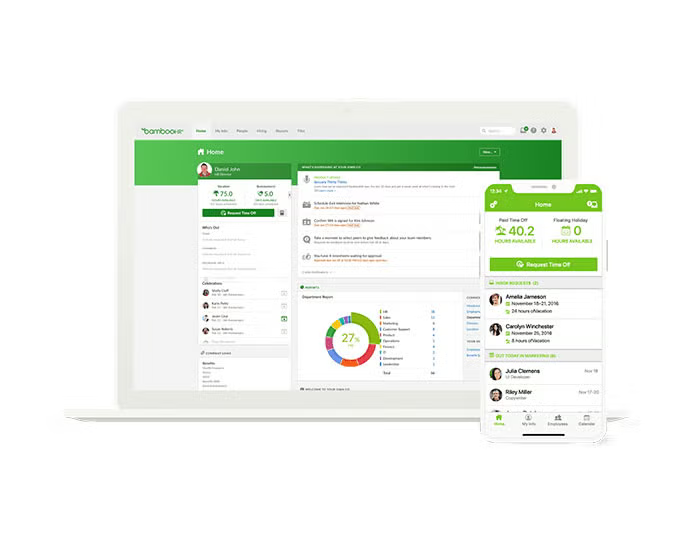

What is it:
HRIS
Best for:
Small-medium businesses
Key Features:
- Accurate reporting
- Applicant Tracking System
- Centralized Employee Database
- Controlled access
- Easy to use system
- Employee onboarding
- HRIS software
- HRMS software
- Performance Management
- Report generation
- SMART reminders (performance)
- Payroll integration
Pros
- Simple layout
- Intuitive UX
- Easy to manage
- Customer Service help is available
- Customizable
- Discounts available for nonprofits
Cons
- Some features have basic functionality
- No built-in scheduling
Customer Review from G2
"BambooHR is extremely easy for managing employee data, submitting time off requests, creating offer letters, and much more. It is incredibly easy to create candidate profiles and send offer letters, and I like the fact that you can monitor the progress after you send an offer letter out."
2. Workday HCM
Workday HCM helps companies with workforce planning, analysis, and execution, providing a robust HR management system. From a modern portal, Workday provides financial and administrative services such as financial planning, HR planning, employee recruitment, payroll processing, and reporting.
While Workday HCM includes a range of human resource management tools, it also offers a module for education. This includes recruiting and admissions, curriculum management, records, advising, and financial aid tracking.
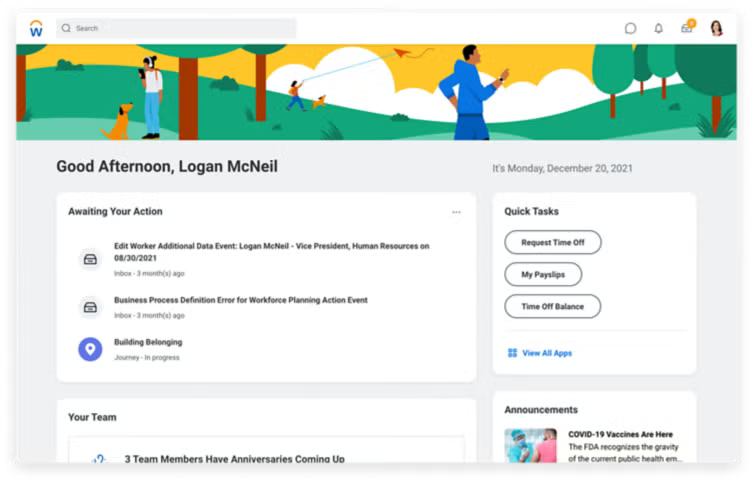

What is it:
HCM
Best for:
Medium-large businesses
Key Features:
- Accounting & Finance
- Revenue Management
- Reporting & Analytics
- Consolidate & Close
- Financial Planning
- Expenses
- Procurement
- Audit Tools
- HRM
- Workforce Management
- Recruitment
- Talent Management
- Onboarding
- Performance Management
- Time & Attendance / PTO Tracking
- Career Pathing
- Succession Planning
- Learning Management System
- Compensation & Benefits
Pros
- A one-stop-shop for all things HR
- Easy for employee adoption
- Simple PTO system
- Streamlined payroll system
Cons
- Scheduled maintenance can be disruptive
- Can be cumbersome to implement
- Steep learning curve
Customer Review from G2
"Workday HCM is an intuitive platform...that is low cost, offers excellent features, capabilities, and perfect synchronization with other talent management platforms, LMS, etc. With this platform you can easily access information about employees, talent management, payroll, etc.
It is easy to use, I like it because it is a powerful and very complete platform with which I can carry out online training for all my employees."
RELATED: Social Recognition Software: What is it and Why Do You Need it?
3. Oracle Fusion Cloud HCM
Natively built for the cloud, Oracle Fusion Cloud Human Capital Management is a comprehensive HR software suite that connects every human resource process across your company. Oracle is a complete solution that covers every human resource process from hire to retire. This solution provides a consistent experience across devices and empowers HR professionals to address company-wide needs.
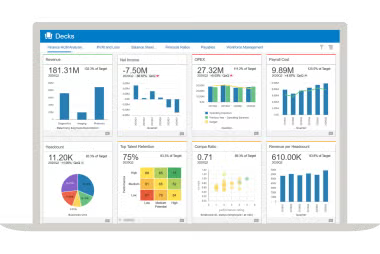

What is it:
HCM
Best for:
Medium-large businesses
Key Features:
- Benefits Provision, Management & Administration
- Time-off & Attendance
- Social News Feed
- Employee Onboarding
- Goal Setting & Tracking
- Custom, Real-time Report Generation
- Employee Profiles
- Payroll Reporting
- 3rdParty Integrations
- Employee Feedback Surveys
Pros
- Easy to configure
- Flexible
- Cloud technology
Cons
- Limited customization
- Data integration can be complex
Customer Review from G2
"Our entire organization finds this application to be user-friendly and can be accessed from mobile devices. It allows employees to utilize all of the self-service functions such as pay slips, and W-4 changes. This application is great for employee goal setting and allows managers to give feedback to the employee without delays."
4. SAP SuccessFactors
SAP SuccessFactors (sometimes referred to by users as “SF” or “SFSF”) is an HR tool that provides cloud-based software for human capital management using the software-as-a-service (SaaS) model.
SAP SuccessFactors incorporates core HR and talent management features, offering its customers various deployment options that tend to specific solution needs.
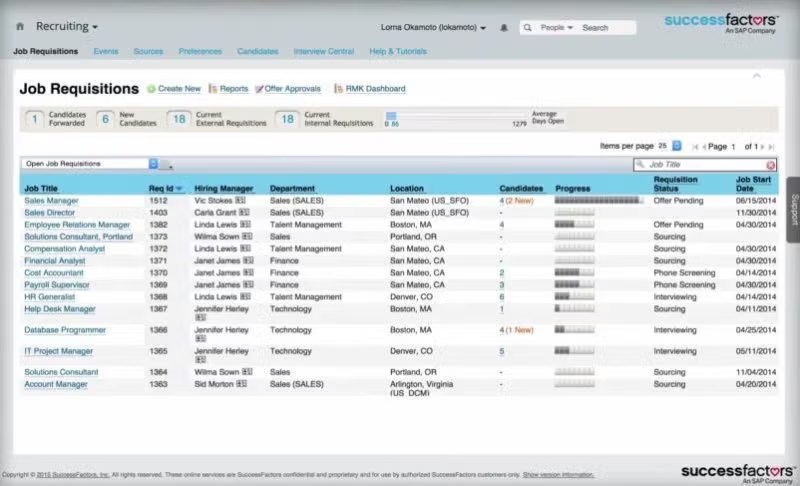

What is it:
HCM
Best for:
Medium-large businesses
Key Features:
- Core HR
- Payroll
- Applicant Tracking
- Onboarding
- Learning Management
- Performance Reviews & Feedback
- Goal Setting
- Compensation Management
Pros
- Easy to set up
- Intuitive UI
- Cloud technology
Cons
- Clunky module integration
- Lacking some reporting capabilities
- Slow customer service/ticket support
Customer Review from G2
"The best thing about SAP's SuccessFactors it allows integration with a vast number of its own products along with different other platforms too. Also, it has many modules starting from recruiting management to Onboarding, Employee Profile, Employee Central, Time Tracking, Litmos, and many more."
5. Paycor
Paycor went public in 2021, showing its move from a regional payroll software solution to a larger national HR software solution. They have taken a best-in-class approach to growing their system, as they’ve acquired cutting-edge ATS, Performance and Engagement solutions.
Paycor is typically a cost-effective option and has performed well in industries like the nonprofit sector where their price point and scheduling capabilities are prioritized.
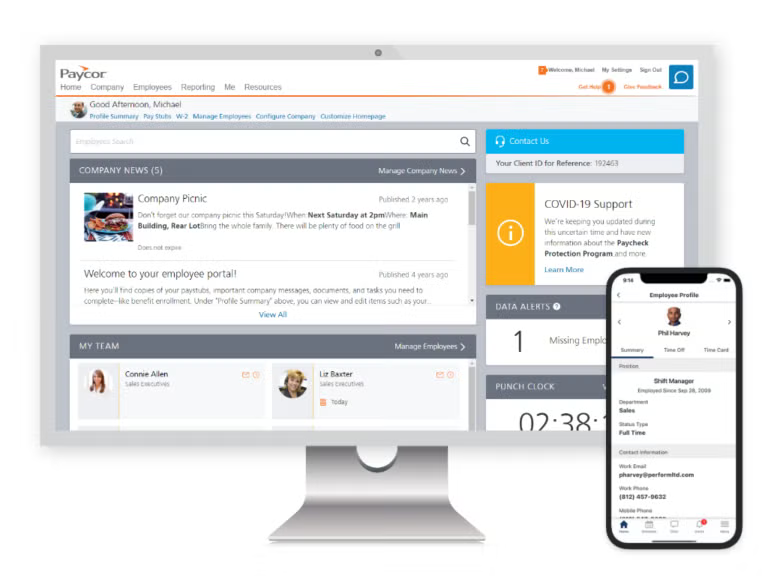

What is it:
HRIS
Best for:
Small-medium businesses
Key Features:
- Payroll
- Benefits Admin
- HR/Employee Files
- Time & Attendance
- Onboarding
- Recruiting
- Learning
- Performance
- Engagement
Pros
- Low cost
- Robust payroll module
- Extensive support team
- Straightforward interface
Cons
- Reports can lack real-time data
- Lacking some reporting capabilities
- Slow customer service/ticket support
- Not a modern interface
- Not great for companies with over 350 employees
Customer Review from G2
"We can keep track of time and attendance of employees, as well as absences due to illness or other causes. It also has performance management, to know the performance and productivity of each employee, as well as the progress of the tasks performed. Payroll management is fast and so far has been error-free."
6. Namely
Namely is designed to be an all-in-one HRIS platform, combining functionalities like payroll, benefits administration, talent management, and even compliance assistance into a single software solution.
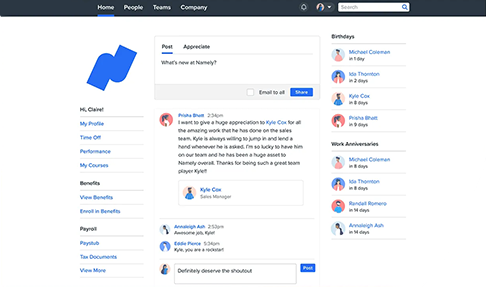

What is it:
HRIS
Best for:
Small-medium businesses
Key Features:
- Payroll
- Benefits administration
- Talent management
- Compliance
- Employee self-service
Pros
- All-in-one solution
- Easy to use
- Scalability
- Employee self-service
- Enhanced services
- Compliance assistance
- Regular updates
Cons
- Limited functionality for larger companies
- U.S.-centric
- Customer service concerns
- Limited reporting
- Potential for errors
- Cost
Customer Review from G2
"Namely's HR and payroll system is easy to use and intuitive. Our employees love it! The platform's user-friendly interface makes it easy to navigate requesting time off, using the Performance Management tool, eSignature function, updating personal profile information, and enrolling in benefits."
7. Rippling
Rippling is a cloud-based HR management platform designed to unify various aspects of managing your employees. It goes beyond standard HR functionalities, aiming to integrate HR, IT, finance, and other related tasks into a single system.
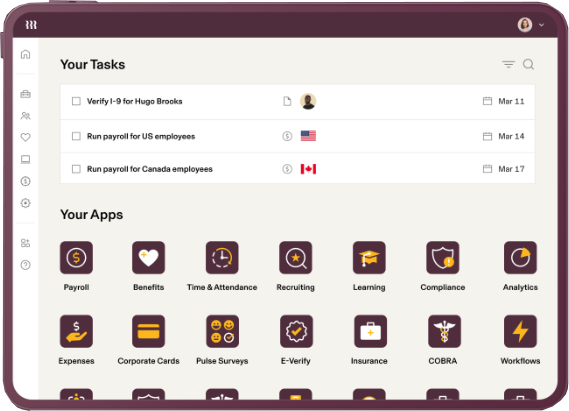

What is it:
HRIS
Best for:
Large global teams
Key Features:
- IT Management
- Finance Management
- All-in-one platform
- User-friendly interface
- Automation
- Scalability
- Global capabilities
Pros
- All-in-one platform
- User-friendly interface
- Automation
- Scalability
- Global capabilities
Cons
- New company
- Limited integrations
- Expensive
- Customer support has been rated poorly
Customer Review from G2
"Having a system that I can rely on to organize employee information, payroll, PTO, and more has made the transition to a smaller team much less stressful.
We were also previously with Gusto who was not able to integrate with our benefits offering and broker. Rippling has completely erased that issue and made benefits, Cobra, and FSA administration so easy!"
8. Gusto
Gusto is a cloud-based software company that provides a comprehensive Human Resource Information System (HRIS) solution specifically designed for the needs of small and medium-sized businesses. Gusto goes beyond just payroll, aiming to be an all-in-one platform for managing various HR functionalities.
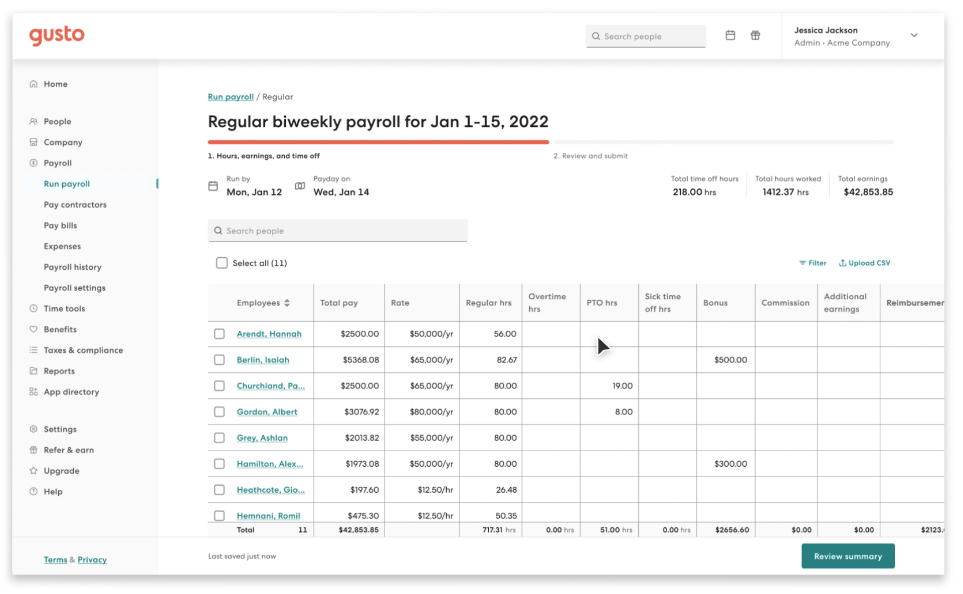

What is it:
HRIS
Best for:
Small to medium-sized businesses
Key Features:
- Payroll processing
- Benefits administration
- Time and attendance tracking
- Employee onboarding
- Employee self-service
- Talent management tools (on some plans)
Pros
- Easy to use
- All-in-one platform
- Scalability
- Time-saving features
- Compliance assistance
- Employee self-service
Cons
- Limited features for large companies
- U.S.-centric
- Limited customer service options
- Possibly expensive
- Limited integrations
Customer Review from G2
"What I like about Gusto is that it helps me focus on what matters - my clients and my team. To keep my business growing, I am focusing on the big picture of networking, seeing clients, and supervising my team to do the same. Gusto takes care of the details like HR documents, time tracking, and timely as well as accurate payroll."
9. Eddy
Eddy is an all-in-one HR and payroll platform for small businesses who have outgrown spreadsheets. It offers the key features you need without the complexity and overhead of larger systems.
This allows HR professionals to streamline administration by combining multiple tools into one simple tool that makes sense for your business. Hire, onboard, manage, and pay employees—all in a single, simple system.
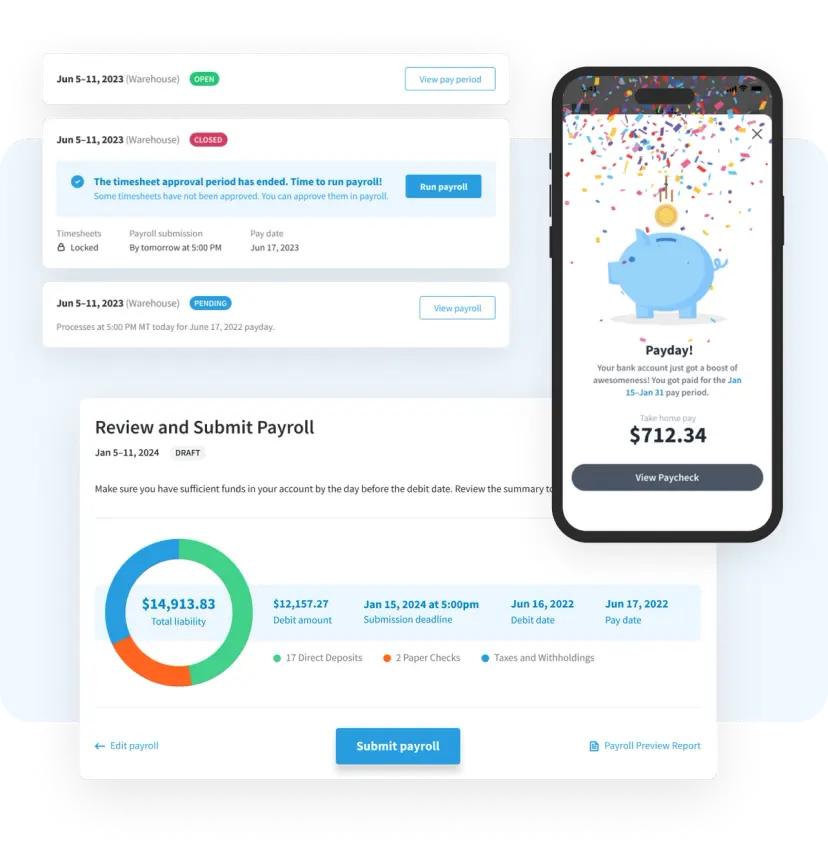

What is it:
HRIS
Best for:
Small to medium-sized businesses
Key Features:
- Benefits administration
- Time and attendance tracking
- Employee onboarding
- Employee self-service
- Applicant tracking
Pros
- User-friendly design
- All-in-one platform
- Cost-effective
- Helpful customer service
Cons
- Limited features for large companies
- Employee management
- Feature issues
- Not ideal for complex needs
Customer Review from G2
"Eddy makes everything SO much simpler in the long run. Another great part? If you email the last person you spoke with from Eddy asking for help (even if that employee is in a new position or left the company), a customer support agent will still reach out in LESS than your typical 24-48 hours.
Usually, my requests are not that urgent, but it is nice to know that they are there when I do need them, which is so hard to find. Our staff uses Eddy daily, and we love the platform. So thankful for Eddy!"
10. Deel
Deel is an all-in-one HR management software for global teams. Compliantly hire, onboard, and pay full-time employees or independent contractors in minutes. You’ll have a central view of your entire workforce in one single place.
With Deel, companies make global payroll possible by leveraging Deel’s in-house back office and locally-owned entities. Workers, managers, and leaders can update withdrawal details, visualize team structure, oversee total payroll spending, and complete dozens of other tasks through Deel’s modern self-serve interface.
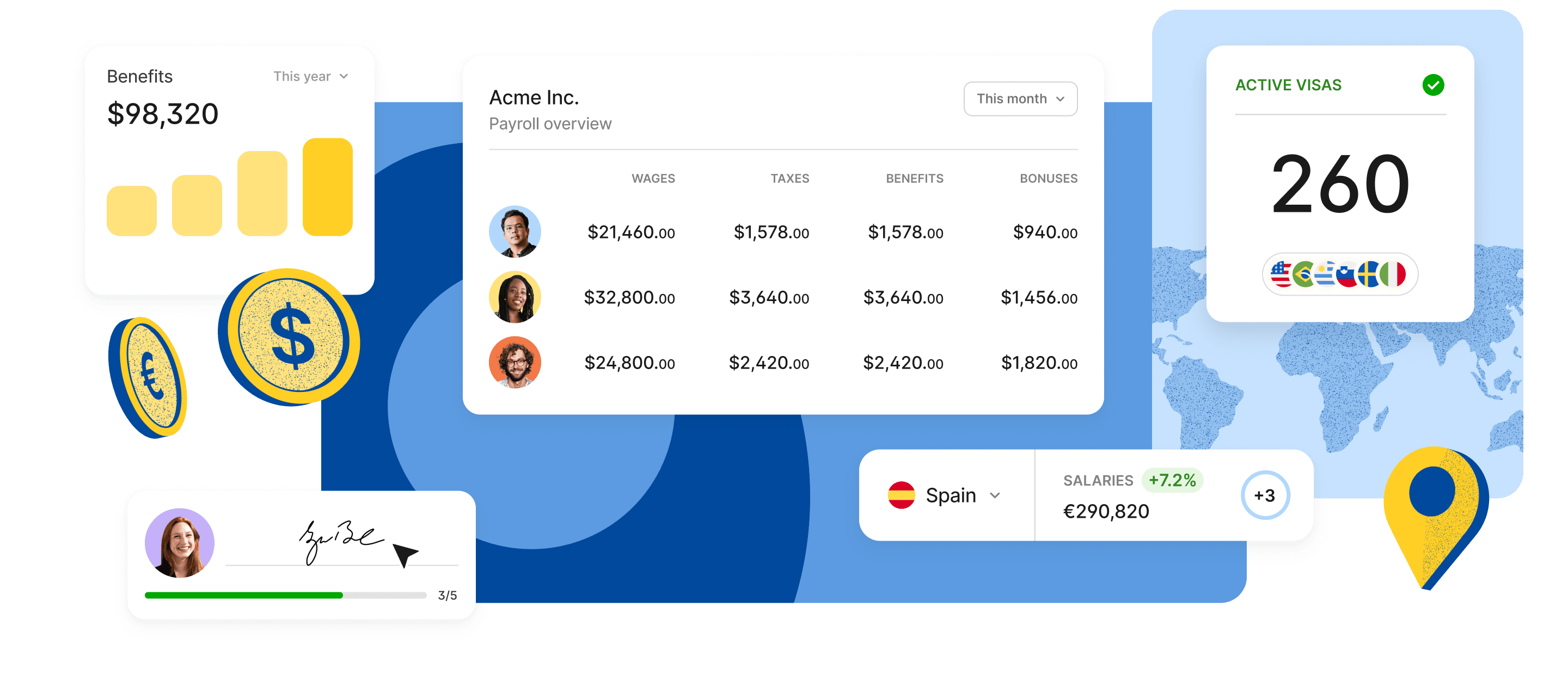

What is it:
HCM
Best for:
Medium-large businesses
Key Features:
- International Hiring
- Global Payroll
- Compliance Management
- Contractor Management
- Benefits
Pros
- Simplified Global Hiring
- Compliance Assurance
- Streamlined Payroll
- Multiple Payment Options
- Integration potential
Cons
- Cost
- Limited HR features
- Limited contractor management
- New to HCM, potential bugs
- Poor customer support
Customer Review from G2
"What I like most about Deel is how easy and affordable it is to use the platform. As a Dominican, I really value solutions that facilitate international transactions without complications or high costs. Deel eliminates many of the usual barriers in managing international contracts and payments, making everything more accessible and manageable from anywhere in the world."
HRIS Features and Functions
HRIS (Human Resource Information System) software is designed to streamline and automate various HR processes, making it an essential tool for HR professionals. The features and functions of an HRIS system can vary depending on the vendor and the specific needs of the organization.
However, most HRIS systems include the following key features and functions:
- Employee Management: HRIS systems provide a centralized platform for managing employee data, including personal details, job information, and benefits. This ensures that all employee records are up-to-date and easily accessible.
- Payroll Management: One of the core functions of HRIS software is payroll management. This includes payroll processing, tax compliance, and benefits administration, ensuring that employees are paid accurately and on time.
- Employee Engagement: HRIS systems can significantly enhance employee engagement through features such as performance management, employee self-service, and talent management. These tools help keep employees motivated and involved in their work.
- Talent Management: Managing the talent pipeline is crucial for any organization. HRIS systems offer features like recruitment, onboarding, and succession planning to help attract, develop, and retain top talent.
- Employee Data Management: A secure and centralized platform for storing and managing employee data is a hallmark of HRIS systems. This includes maintaining employee records and benefits information, ensuring data integrity and security.
- Free Trial: Many HRIS vendors offer a free trial or demo of their software. This allows organizations to test the system before committing to a purchase, ensuring it meets their specific needs.
- HRIS Systems Integration: HRIS systems are designed to integrate seamlessly with other HR systems, such as payroll software, benefits administration, and employee self-service portals. This integration streamlines HR processes and improves efficiency.
- Human Resources Management System: HRIS systems are a type of human resources management system that helps organizations manage their HR processes more efficiently. They provide a comprehensive solution for all HR needs.
- Benefits Administration: Managing employee benefits can be complex, but HRIS systems simplify this process. They offer features for benefits enrollment, tracking, and reporting, ensuring employees receive the benefits they are entitled to.
- Employee Self-Service: Empowering employees to manage their own HR information is a key feature of HRIS systems. Through self-service portals, employees can update personal details, request time off, and access performance management tools.
- HR Management: HRIS systems provide a centralized platform for managing all HR processes, including recruitment, onboarding, and employee data management. This centralization improves efficiency and reduces administrative burden.
- Cloud-Based: Many HRIS systems are cloud-based, offering greater flexibility and scalability. Cloud-based HR software allows organizations to access their HR data from anywhere, at any time.
- HR Software: HRIS systems are a type of HR software that helps organizations manage their HR processes more efficiently. They offer a range of features to support HR professionals in their daily tasks.
- HRIS Software: Designed to integrate with other HR systems, HRIS software provides a comprehensive solution for managing HR processes. This includes payroll software, benefits administration, and employee self-service.
- Applicant Tracking: HRIS systems can streamline the applicant tracking process, from job postings to resume screening and interview scheduling. This ensures a smooth and efficient recruitment process.
- Employee Records: Maintaining accurate and up-to-date employee records is crucial for any organization. HRIS systems provide a secure and centralized platform for storing and managing these records.
- Core HR: HRIS systems offer a centralized platform for managing core HR processes, including recruitment, onboarding, and employee data management. This centralization improves efficiency and reduces administrative burden.
- Time and Attendance: Managing time and attendance is a critical function of HRIS systems. They offer features for time tracking, attendance tracking, and leave management, ensuring accurate and efficient workforce management.
- Employee Performance: HRIS systems can help organizations manage employee performance through features like performance management, goal setting, and performance evaluations. This ensures employees are meeting their objectives and contributing to the organization’s success.
- Performance Management: A centralized platform for managing performance management processes is a key feature of HRIS systems. This includes performance evaluations, goal setting, and employee development planning.
- Workforce Management: HRIS systems offer comprehensive workforce management features, including workforce planning, workforce analytics, and workforce optimization. These tools help organizations manage their workforce more effectively.
By understanding the features and functions of an HRIS system, organizations can better evaluate their HR software needs and select a system that meets their specific requirements.
Benefits of an HRIS or HCM


HRIS and HCM systems offer a variety of benefits for organizations of all sizes, making them essential HR technology solutions. Here’s a breakdown of the key advantages:
Improved Efficiency and Streamlined Processes:
Automation: Both HRIS and HCM automate many manual employee management tasks, such as payroll processing, benefits administration, and time and attendance tracking. This frees up HR professionals' time to focus on more strategic initiatives like talent management and employee relations.
Centralized Data: An HRIS or HCM system acts as a central repository for all employee data, eliminating the need for multiple spreadsheets and paper files. This ensures data consistency, simplifies access, and reduces errors.
Self-Service Options: Employees can access their HR information, update personal details, request time off, and view payslips through a self-service portal. This reduces workload for HR and empowers employees to manage their information.
Enhanced Data Accuracy and Compliance:
Reduced Errors: Automation and centralized data storage minimize the risk of errors in calculations, reporting, and record-keeping.
Compliance Management: HRIS and HCM systems can help organizations stay on top of relevant HR regulations and ensure compliance with labor laws.
Better Decision-Making and Strategic Talent Management:
Reporting and Analytics: Both HRIS and HCM offer reporting and analytics tools that generate insights into key HR metrics, such as turnover rates, time off usage, and workforce demographics. This data can be used to inform strategic decisions about staffing, compensation, and talent development.
Talent Management Features: HCM systems often include features for applicant tracking, performance management, and learning management. These features can help organizations attract and retain top talent, improve employee performance, and develop future leaders.
Additional Benefits:
Improved Employee Engagement: Self-service options and easier access to HR information can empower employees and improve overall satisfaction.
Scalability: HRIS and HCM systems can be scaled to accommodate the needs of growing businesses.
Integration Capabilities: Many HRIS and HCM systems integrate with other business tools like accounting software and time-tracking apps. This can streamline workflows and improve data flow across different departments.
Choosing Between HRIS and HCM:
HRIS: Ideal for organizations that primarily need to manage core HR tasks, centralize employee data, and improve efficiency.
HCM: A more comprehensive solution that offers all the features of an HRIS, plus additional functionalities for strategic talent management and workforce planning.
Overall, both HRIS and HCM systems can be valuable tools for organizations looking to streamline HR processes, improve data accuracy, make better decisions, and manage their workforce more effectively. The best choice for your organization depends on your specific needs, budget, and size.
Looking for More Ways to Improve Employee Engagement?
While this HRIS systems list is a great place to start automating processes, there are more ways to engage your employees and improve retention and morale.
One way is with employee recognition. If you’re interested in getting started with social recognition software, Terryberry is here to help.
Contact us to learn more or schedule a demo. Our employee recognition software is designed to incorporate social recognition, performance awards, milestone awards, and communication channels all in one place.



